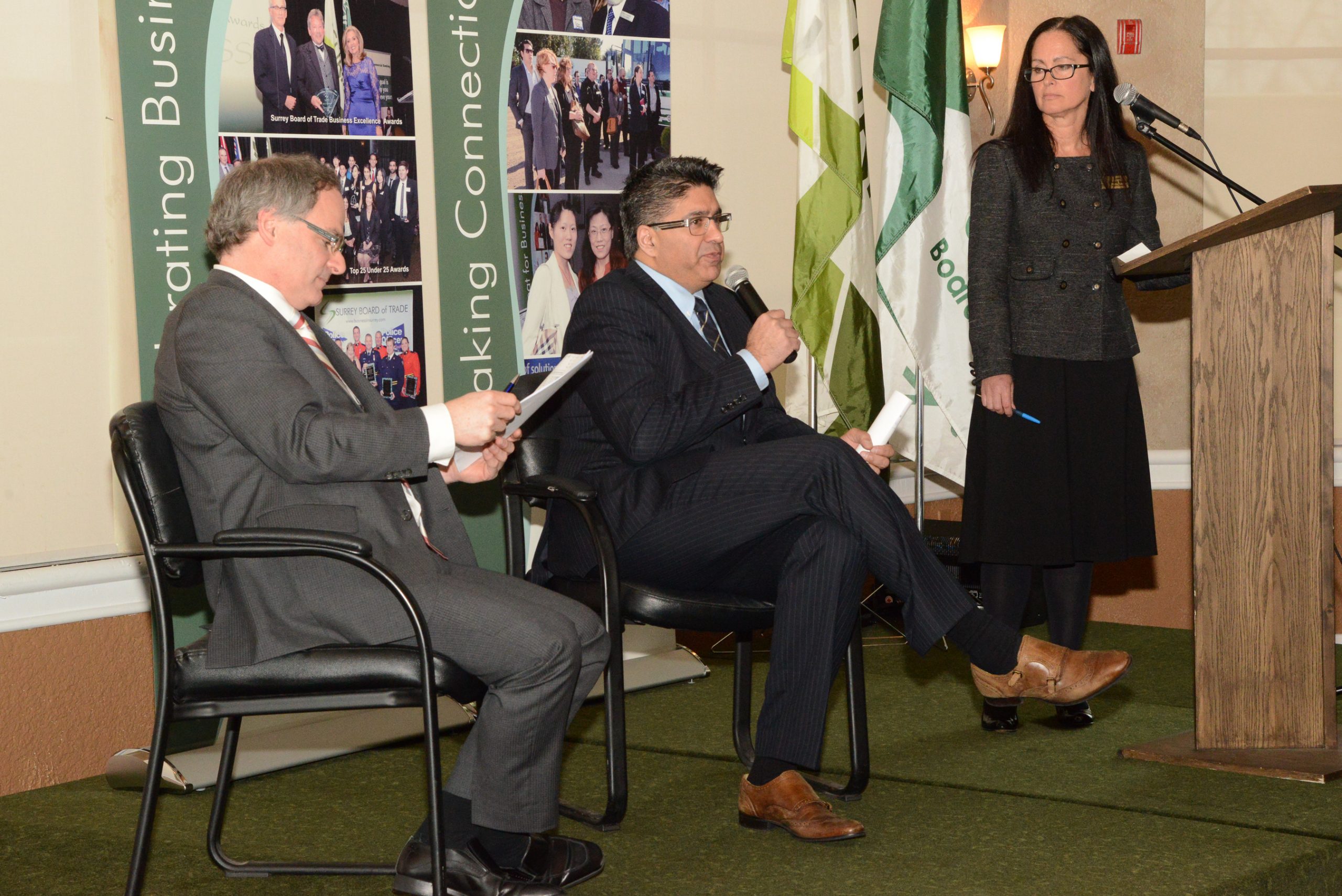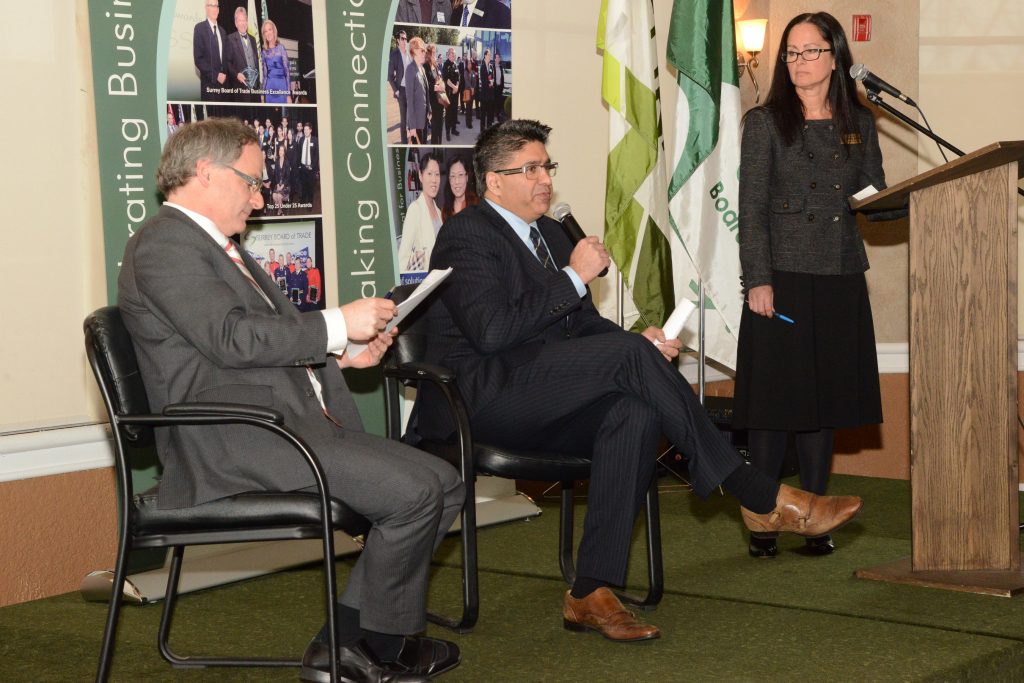

Critical For Surrey’s Future Development
by Ray Hudson
Surrey: Ken Peacock, Chief Economist and Vice President of the Business Council of BC, provided an economic snapshot of the financial state of the country, saying he generally felt that although growth will be slow, the strength of the US economy will benefit Canada. The US economy is growing and doing relatively well, showing the strongest employment growth in a decade and a half. Consumers are spending, households are paying down debt, and corporations “are sitting on a bunch of cash looking to deploy it.” This is good for Canada and BC. Surrey, which continues to lead the country in growth, will be in better shape for some time.
Tom Gill addressed three points; The critical need for investing in Surrey’s infrastructure, Surrey’s infrastructure priorities and the city’s perspective on the 2016 Federal Budget.
“Some people think of infrastructure as roads, water and sewer. But it’s really about people,” said Gill. “The senior government has finally recognized it’s time to invest in people and in our community. I’ve learned that society needs on-going and continuing investments in transit, in roads, in clean energy, affordable housing, child care, community recreational amenities whether they’re pools, ice rinks, libraries or Recreation centers. All infrastructure investments are crucial for economic growth to be possible. Vital community amenities are building blocks that connect people to their communities. Investment in these amenities is socially responsible and the right thing to do.”
He said the investment was about residents having decent well-paying jobs, enabling them to support their families in a safe environment. It’s about providing them with a good quality of life and being invested in the community. It’s about being a proud resident and belonging to your community. Infrastructure can do that and more.
Gill said strategic investments can stimulate the economy and help build strong sustainable and inclusive communities. As for the cost of not investing, he cited a CD Howe Institute report which suggested that congestion in Metro Vancouver was costing up to $1.2 million per year. With respect to families, the Department of Justice estimated the total economic cost of domestic violence (as of 2009) was $7.4 billion, and according to the Federation of Canadian Municipalities (FCM), homelessness costs Canadians an estimated $7 billion annually.
“These are huge costs,” said Gill. “It’s like building twenty Port Mann bridges per year, every year. Strategic Investment? I have a personal motto: pay now, or pay later.”
Surrey’s infrastructure priorities: Surrey identified $3.7 billion in construction projects, and most of them are shovel-ready. Of that $3.7 billion, $2.6 billion is for rapid transit networks linking the communities, $1.1 billion has been designated to the “L” Line connecting Guildford, City Centre and Newton. $1.5 billion is going to be for the Fraser Highway line to Langley City, and a further $1.1 billion for other infrastructure improvements. The council is hopeful that there will be a line to connect the balance of the town centres making the “L-Line” the “O” Line.
“I’ve been a passionate advocate for transit in Surrey, and I can confirm that the LRT remains the top priority of the infrastructure projects,” said Gill. “Rapid transit is only effective if it’s safe, affordable, reliable, and efficient. A big problem we have is something called ‘Pass-by’ which means if a bus is full, the driver will not stop. You’ll have to wait for the next bus. This is why a vehicle is a necessity in Surrey, and why we have so many of them on our streets. A robust transportation system allows people to commute efficiently and effectively and with confidence. I believe, as municipal leaders in this industry, we are setting new best practices and benchmarks.”
“We also have a sustainability charter in Surrey which was adopted in 2008. It’s a plan to help guide our policy and decision-making and to ensure that Social, Environmental, and Economic matters are taken into consideration in making policy decisions. We also have a biodiversity conservation strategy. It’s a plan to preserve, protect, and enhance Surrey’s biodiversity.”
Organic waste fuel facility to open in 2017 first of its kind in North America – closed loop system to process organic waste into 100% renewable natural gas to fuel the garbage trucks.
Affordable housing – the goal of the housing action plan –is to have an adequate supply of housing to meet the full range of incomes and needs throughout the city
Social infrastructure continuing investment in parks. In the last 10 years Surrey has invested $804 million, almost 2x the amount invested in the previous 10 years.
Other Infrastructure Priorities include: $90 million for new spectator sports facility; $45 million to replace the North Surrey arena; $150 million for a new city centre performing arts centre seating 1200 for community events and world class performances; in South Surrey, $35 million for a performing arts centre with exhibition space and 300 seat performance space; $40 million for a new arts and library centre facility in East Clayton, and $7 million for museum expansion.
Traditional Infrastructure Priorities include: $400 million dyke improvements; $17 million for a district energy plan; $15 million on sewer replacement; $11 million on LED street lighting; $500 million to improve the interchanges, the drainage issues, bridges and overpasses, sidewalks and park buildings.
Comments on the 2016 Budget:
“I feel it indicates the Federal government understands the needs of municipalities and the importance of working with local government with the projects like the city’s LRT,” the Counsellor said, referring to the new infrastructure fund for the accelerated design and implementation of the light rail transit lines planned for Surrey.
“What is most encouraging for me is the federal government’s move away from the
one-third federal, one-third provincial and one-third TransLink funding model increasing the federal share to fifty percent to get these projects moving quickly. Our job is to continue to work with the provincial and federal governments to ensure that we can solidify the criteria around accessing the funds.”
Following the presentation, Gill spoke with Ray Hudson:
Q: The South Fraser region has always tended to be the poor cousin of the municipalities north of the Fraser. With the dramatic growth of Surrey do you see this disparity improving, or should the south look toward establishing its own regional district?
Gill: In years past, there’s been no question that we have not received our fair share. But we’ve had both commitments and conversations with our new MPs, commitments from the Prime Minister, who visited our great city on numerous occasions, with some significant ministers and their staffs, there’s no question in my mind things are significantly different. I do envision that it’s our turn, and there’s no question that we as a city, are a priority to this government.
On a positive note, I think the provincial government has done a good job of making infrastructure investments throughout the municipalities in the Lower Mainland. I know that we’ve knocked off a couple of big projects including the South Fraser Perimeter Road and the Port Mann Bridge. The other issues that we have are being addressed or have been dealt with, so hats off to the politicians at the senior levels.
Q: What do you see as the positive and negative impacts of this rapid population growth on Surrey?
Gill: I recently received an email from a young man and his wife, who are both university educated with a combined income of $90,000 per year, and they’re struggling. That leads one to wonder about the many others who have less. There’s no question in my mind that affordability is a huge concern, whether it’s housing or ensuring that your family is able to meet their needs.
Q: One element I didn’t hear a lot about in the presentations today concerns growing manufacturing in our area. What plans are there to foster this sector?
Gill: We’ve got the population. One third of our population is under the age of nineteen. I think the direction of the city is to have more educational institutions here that will be able to specialize with some of these manufacturing industries. We’re very blessed to have significant land in Campbell Heights, in southeast Surrey, for commercial and industrial development with the potential for job creation (employment lands), that other municipalities don’t have. So do I see manufacturing as being a big part of Surrey, the answer is simply yes. Do we have employment lands? Absolutely! So it’s merely just marrying the folks that are doing the work with the investors, and the land. It’s really a win, win, win for us.












